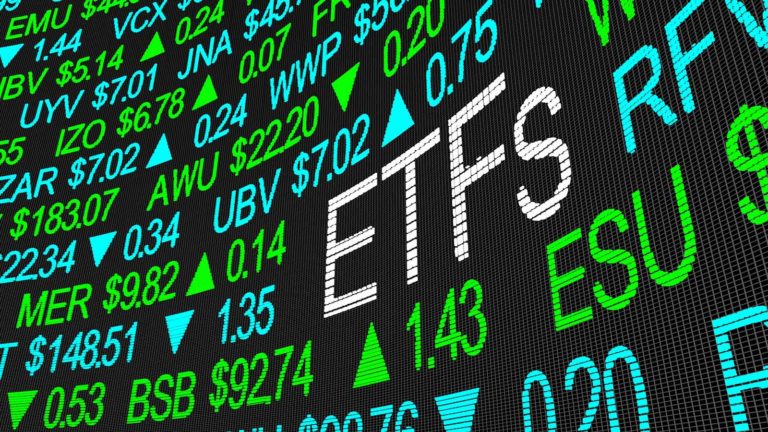High dividend yield ETFs gained popularity when interest rates were near zero because investors found it hard to generate sufficient income from their investments. That was especially true regarding guaranteed investments such as U.S. Treasuries.
As a result, investors went hunting for higher yields, often attempting to thread the needle between safety and income. Now that we have the highest interest rates since the financial crisis, finding fixed-income ETFs that do the job has become slightly more manageable.
But what about equity ETFs? Which are the best high-yield ETFs that invest in stocks?
The S&P 500 average dividend yield is 1.54%. Therefore, a high-yield ETF would yield at least 2-3x the index average. So, the best high dividend yield ETFs in my book are those between 3.1% and 4,62%. They are high, but not too high, where the company quality tends to be lower.
Here’s to higher yields.
Schwab US Dividend Equity ETF (SCHD)

Schwab US Dividend Equity ETF (NYSEARCA:SCHD) is down 6.4% year-to-date and is at its lowest since last October. It yields 3.7%.
The ETF tracks the performance of the Dow Jones U.S. Dividend 100 Index, a collection of U.S.-listed stocks with sustainable, high-yield dividends. The index is a subset of the Dow Jones US broad market index, excluding real estate investment trusts (REITs), master limited partnerships (MLPs), preferred stocks, and convertibles.
ETF got its start in October 2011. Since then, it has cobbled together $45.5 billion in net assets. It charges a low 0.06%, or $6 per $10,000 invested. It has 102 stocks with an average weighted market capitalization of $149.2 billion and a price-to-earnings ratio of 13.9x.
The three top sectors by weighting are industrials (17.8%), healthcare (16.3%), and financials (14.1%). As suggested by the average weighted market cap from above, nearly 70% of the portfolio are companies with market caps of $70 billion or greater. The top 10 holdings account for 42% of the ETF’s net assets. Its top holding is PepsiCo (NASDAQ:PEP) at a weighting of 4.6%.
Morningstar.com gives it a five-star rating.
iShares Select Dividend ETF (DVY)

iShares Select Dividend ETF (NYSEARCA:DVY) has to have one of the best symbols of any dividend ETF out there. It’s hard not to know immediately what it’s all about. Morningstar.com gives it four stars. It currently yields 3.8%.
The ETF tracks the performance of the Dow Jones U.S. Select Dividend Index, a collection of 100 of the highest dividend-yielding U.S.-listed stocks. The index is a subset of the Dow Jones US Broad Market Index, excluding REITs.
To qualify, a stock must have a current dividend per share that’s higher than its five-year average, a dividend coverage ratio — defined as annual earnings per share divided by annual dividend per share — of 167% or greater, a three-month average daily trading volume of 200,000 shares (100,000 shares for current constituents), it must have paid dividends in the previous five years, and its trailing 12-month EPS must be positive.
That’s a lot to say; it looks for ETFs that have paid dividends in each of the last five years at the very minimum.
The ETF’s been around since November 2003. It has $ 20.0 billion in net assets, and charges a reasonable 0.38%, or $38 per $10,000 invested. And it also has 100 stocks with an average weighted market capitalization of $26.0 billion and a P/E ratio of 11.9x.
If you like mid-cap stocks, DVY should be right up your alley. Small- and mid-cap stocks account for 64% of its net assets.
Vanguard FTSE Emerging Markets ETF (VWO)

Heading outside the U.S. for my final selection, the Vanguard FTSE Emerging Markets ETF (NYSEARCA:VWO) yields a healthy 3.8%. Morningstar gives it four out of five stars.
The ETF tracks the performance of the FTSE Emerging Markets All Cap China A Inclusion Index, a collection of stocks in companies from emerging markets such as China, Brazil, Taiwan, and South Africa.
There is no question that emerging markets stocks Have underperformed over the past five years. VWO is down 11.7% over this time. However, if you believe in reversion to the mean, it’s a low-cost — it charges 0.08% or $8 per $10,000 invested — way to play a resurgence in these stocks due to a bear market in U.S. stocks.
Around March 2005, the ETF has $71.3 billion in net assets, a sign that VWO is very popular with investors trying to gain exposure to emerging markets. It is a broad-based ETF with 5,710 stocks, 25% higher than the benchmark index. The median market cap is $18.5 billion, with a P/E ratio of 11.6x and an earnings growth rate of 14.5%.
The three top countries by weighting are China (34.0%), Taiwan (17.4%), and India (16.9%).
On the date of publication, Will Ashworth did not have (either directly or indirectly) any positions in the securities mentioned in this article. The opinions expressed in this article are those of the writer, subject to the InvestorPlace.com Publishing Guidelines.
